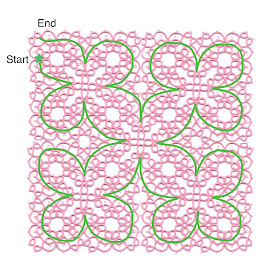Beginning in the corner makes it less fiddly when finishing the square, however, there is also a hidden benefit to starting in this position. Each time a triangle is completed (such as the one pictured above), I have two options. I can work clockwise and continue to make a larger triangle (and thus a larger magic square) or I can work counter clockwise (where the shuttles are placed) to finish the square.
To understand this concept more clearly, picture each magic square as being composed of four triangles. The first, and smallest of the magic squares can be represented like this:
Tatting a slightly larger triangle (a combination of the bottom and rightmost triangles pictured above) creates a new magic square:
Using a simple collage app and drawing app on my iPad, I can get an idea of what each new magic square would look like. Option three, which is how I initially intended to make my magic square, looks like this:
To get really crazy, a fifth option (which I don't have the stamina to complete) would look like this:
All in all, I think this is a really neat experiment and I am excited to see what the finished square will look like.










